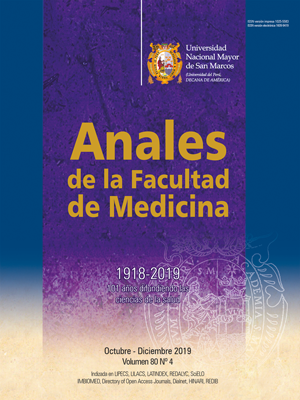Effect of preprandial exercise on basal and postprandial intermediary metabolism on people with type 2 diabetes at high altitudes
DOI:
https://doi.org/10.15381/anales.v80i4.17252Keywords:
Altitud, Diabetes Mellitus tipo 2, Ejercicio, MetabolismoAbstract
Introduction. The population living on high altitudes areas has a different intermediate metabolism than people who is living on coastal areas, characterized by lower glycemia levels. In patients with type 2 diabetes, who reside at high altitudes, the effect of exercise has not yet been fully studied. Objective. To study the effect of short duration and casual exercise, on basal and post-prandial metabolic control in people with type 2 diabetes (DM2), residents at 3395 msnm. Methods. 14 women and 11 men with DM2, residents at high altitudes (Cusco, 3395 msnm), between 40 to 72 years old, who were intervened with two tests: baseline (A) and pre-postprandial exercise (B) consisting of a walk, for 30 minutes, at 4 Km/h (3 METS). Glucose, total cholesterol, HDL, triglycerides, insulin and non-esterified fatty acids (AGNE) were measured in the blood on fasting and after a breakfast with 730 Kcal (55,4% fat, 37,2% carbohydrates and 7,3% protein), for six hours. Additionally, total cholesterol, VLDL, LDL, NoHDL and HOMA-IR levels were calculated. Results. Statistically significant decrease (p<0,01) was found between the mean baseline (230,2 mg / dL) and post-prandial (115 mg / dL) glycemia. Conclusion. The exercise improved post-prandial glycemic control in DM2 in people who are living in high altitudes.
Downloads
Published
Issue
Section
License
Copyright (c) 2019 Anales de la Facultad de Medicina

This work is licensed under a Creative Commons Attribution-NonCommercial-ShareAlike 4.0 International License.
Those authors who have publications with this magazine accept the following terms:
- Authors will retain their copyrights and guarantee the journal the right of first publication of their work, which will be simultaneously subject to Creative Commons Attribution License that allows third parties to share the work as long as its author and its first publication this magazine are indicated.
- Authors may adopt other non-exclusive licensing agreements for the distribution of the version of the published work (eg, deposit it in an institutional electronic file or publish it in a monographic volume) provided that the initial publication in this magazine is indicated.
- Authors are allowed and recommended to disseminate their work over the Internet (eg: in institutional telematic archives or on their website) before and during the submission process, which It can produce interesting exchanges and increase quotes from the published work. (See El efecto del acceso abierto ).



